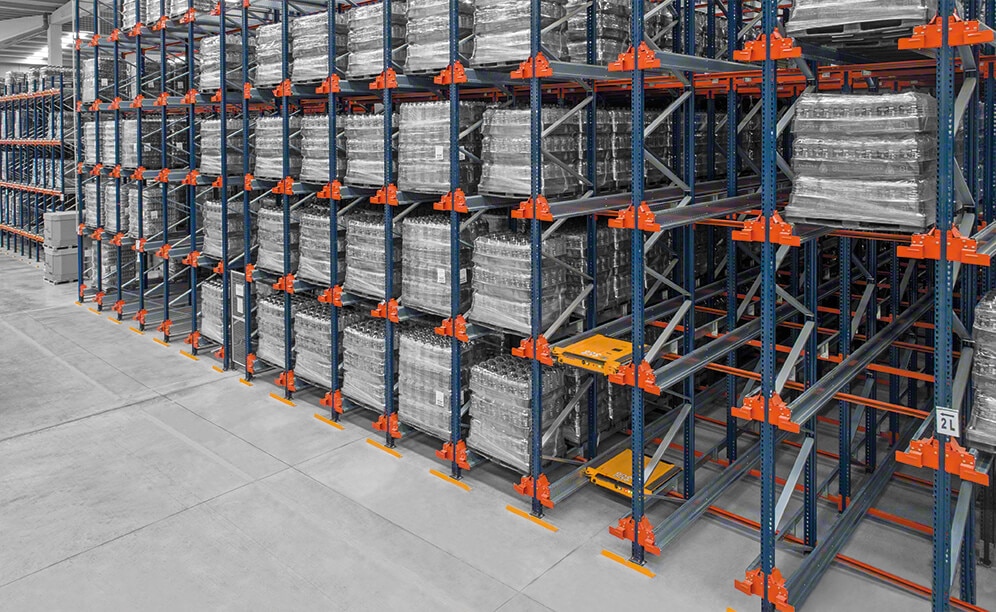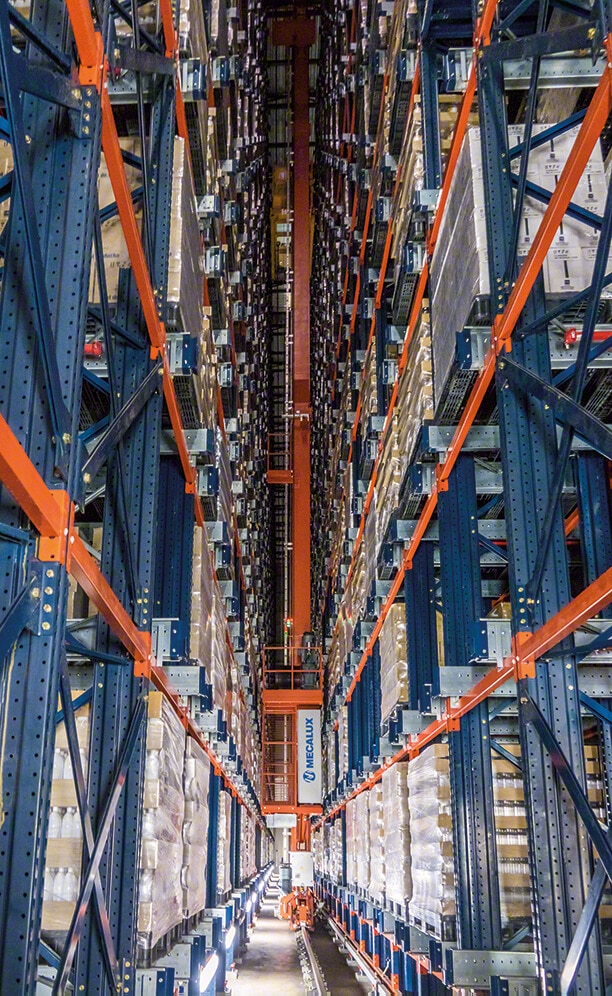Compact storage systems feature a higher storage density by optimising available warehouse space. Of all these, the Pallet Shuttle system is the one that best enhances an installation’s productivity because an electric shuttle moves goods through the channel automatically. The combined benefits of compactness and automation make the Pallet Shuttle system the ideal solution for companies that need to maximise storage capacity while also increasing productivity.

Businesses today face many logistical challenges. Having more storage capacity in a limited area is one of the most difficult issues to tackle.
To this end, it is standard practice to install these space-saving compaction storage systems because they maximise room and, therefore, fit a larger number of pallets.
These high-density systems include traditional solutions (drive-in, push-back, live or semi-automatic Pallet Shuttle racking) and automated solutions (Pallet Shuttle system with stacker cranes or transfer cars). Each of them has its own unique features, advantages and applications, although they share some common traits:
- They utilise the warehouse area by reducing the number of aisles and, as a result, achieve greater storage capacity.
- They are often used for storing multiple pallets of the same SKU.
- Each lane (in the drive-in racks) or each level of a lane (in the push-back, live and Pallet Shuttle racks) is assigned the same SKU.
- They only give direct access to the pallet that coincides with the working aisle.
- In traditional solutions, counterbalanced forklifts and reach trucks are used to handle goods.
Traditional compact system vs the semi-automatic Pallet Shuttle
When choosing which compact storage system to install in the warehouse, one must assess not only the storage capacity, but also the flows, the number of available SKUs and the company’s logistics requirements. Each system has specific characteristics that must be understood if you want the right solution to solve a problem in a particular warehouse and to get the most out of the chosen solution.
The following are distinguishing features of each of the traditional compact systems:
Drive-in pallet racking: high-density at a low cost
They are made of a set of racks that have storage lanes inside. In turn, these lanes are equipped with rails to support the pallets. Operators drive forklift trucks to store or extract pallets from the racking. These machines move along the inner storage lanes with the load lifted above the level on which it will be stored.
Their lower cost, space saving and almost non-existent maintenance make drive-in pallet racks the most cost-effective option for compact systems.
Push-back pallet racking: for average consumption products (type B)
They are set with a slight gradient. The front side is lower so that, by taking a pallet out, those behind it slide through gravity down to the first exit point position. With this system, goods are managed according to the LIFO (last in, first out) principle, i.e. the last pallet to enter is the first to leave. Thus, the operators deposit or extract the goods from a single working aisle.
Unlike drive-in racking, with push-back racks, the forklift does not enter the storage lanes, as both pallet loading and unloading are done from the working aisle. By doing so, handling times are much shorter. It is a system that holds more SKUs than drive-in racks, as each storage channel can contain a different SKU.
Live pallet rack: ideal for perishable products
Channels are fitted with rollers and speed controllers. With this system, there are no aisles to access the goods, as only the loading and unloading aisles are enough to do the job.
It is the only compact system that ensures the flawless rotation of the goods because it meets the FIFO (first in, first out) method requirements: the pallets are inserted on the highest side of the racks and slide by gravity to the opposite end. Therefore, it is highly suited for storing perishable products or products with short expiry dates that require high turnovers.
Semi-automatic Pallet Shuttle: capacity and productivity
The Pallet Shuttle is a semi-automated high-density storage system in which a shuttle with an electric motor runs along rails within the storage channels in order to load and unload the goods.
This system works in a very straight-forward way: using a forklift, the operators insert the motorised shuttle into the channel in which the goods are to be stored. The Pallet Shuttle moves the pallets to the deepest available position or, vice versa, picks up the first pallet found in the channel and moves it to the exit.

What are the benefits of the semi-automatic Pallet Shuttle system?
- Optimum use of space. Storage channels can be more than 40 m deep.
- Increased productivity. The pallets move fully automated, increasing the flow of goods in and out of the warehouse.
- Reduces spending. Highly cost-effective, thanks to the lower operating costs. Furthermore, space used well equals less floor surface costs.
- Versatility. It is a system that adapts to the dimensions of the warehouses. It can also be combined with other storage solutions.
- Maximum safety. Since it is not necessary to drive forklifts into the lanes, the risk of accidents is almost non-existent, so the metal structures remain undamaged.
Warehouse layout with a semi-automatic Pallet Shuttle system
Racking block distribution with the semi-automatic Pallet Shuttle has a direct effect on storage capacity. It also influences the way in which goods are managed and, consequently, the speed products enter and leave.
Mecalux searches the solution that best adapts to each customer’s specific needs, which will vary depending on the number of SKUs, the quantity of pallets and how the goods are received and dispatched.
1. A single front aisle
- Greater storage capacity.
- High number of locations.
- LIFO merchandise management.
2. Two access aisles: one for inputs and one for outputs
- Less storage capacity than using a single aisle.
- High number of locations.
- FIFO merchandise management.
3. A working aisle and racks on both sides
- Increased number of locations compared to previous solutions.
- Shallower channels.
- LIFO merchandise management
The Pallet Shuttle system is usually installed in:
- Companies with a large number of pallets per SKU.
- Cold stores. There is less volume that must be refrigerated since it is a compact storage system and, as such, there is reduced power consumption.
- Temporary storage buffer.
- Seasonal product warehouses or warehouses with season-based inflows and outflows.
- Warehouses that already use a high-density system and want to increase productivity by shortening loading and unloading times.
Nestlé Purina
|
Héctor Olmos |
When and how to automate a compact storage system

Companies with compact systems that want to increase their logistics centre’s productivity may consider fully automating their operations by replacing a forklift with automated handling equipment.
This system can be automated by introducing stacker cranes or transfer cars. Choosing between one piece of handling equipment or another will depend on the required number of inbound and outbound movements, the number of SKUs and the number of pallets per SKU or batch.
Stacker cranes. These are responsible for moving pallets from the warehouse inflow-outflow positions to any storage channel. Once there, the Pallet Shuttle transports them from the stacker crane’s cradle to the interior of the channel.
Transfer cars. A walkway structure is installed so that a shuttle moves through each level. This transfer car carries out the movements from the lifts to the storage channels on each level. Thus, the number of movements or cycles/hour is multiplied by the number of levels in a warehouse.
The automatic Pallet Shuttle system is recommended in the following cases:
- Installations where very high yields are required, with a high product rotation and where maximum use of space is essential.
- Companies with massive stock counts, with medium and high consumption SKUs, or with a large number of pallets per SKUs.
- Cold stores.
- Temporary storage buffer.
Compaction and automation
The Mecalux Pallet Shuttle system, in both its semi-automatic and automatic versions, is the best solution for companies whose priority is to increase the capacity and productivity of their warehouse while also reducing operational costs.
In short, the Pallet Shuttle is the evolution of the compact storage systems, providing greater storage capacity, speed and productivity.
Its capabilities add value to the company’s logistics activity and, at the same time, compensate for the initial investment with a short-term cost reduction and a rapid ROI.
Bem Brasil
|
João Emílio Rocheto |


